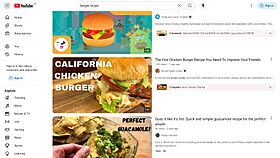YouTube facts for kids
|
Logo used since 2024
|
|

YouTube search results, November 2024
|
|
| Type of business | Subsidiary |
|---|---|
|
Type of site
|
Online video platform, Social media platform |
| Founded | February 14, 2005 |
| Headquarters | 901 Cherry Avenue San Bruno, California, United States
|
| Area served | Worldwide (excluding blocked countries) |
| Owner | Alphabet Inc. |
| Founder(s) | |
| Key people |
|
| Industry | |
| Products |
|
| Revenue | |
| Parent | Google LLC (2006–present) |
| IPv6 support | Yes |
| Advertising | Google AdSense |
| Registration |
Optional
Not required to watch most videos; required for certain tasks such as uploading videos, viewing flagged (18+) videos, creating playlists, liking or disliking videos, and posting comments
|
| Users | |
| Launched | December 15, 2005 |
| Current status | Active |
|
Content license
|
Uploader holds copyright (standard license); Creative Commons can be selected. |
| Written in | Python (core/API), C (through CPython), C++, Java (through Guice platform), Go, JavaScript (UI) |
YouTube is a huge online platform where people can watch and share videos. It's owned by Google, a very large technology company. YouTube was started on February 14, 2005, by three friends: Steve Chen, Chad Hurley, and Jawed Karim. They used to work for a company called PayPal.
YouTube's main office is in San Bruno, California, in the United States. It's the second most visited website in the world, right after Google Search. In early 2024, over 2.7 billion people used YouTube every month. Together, they watched more than a billion hours of videos each day! People upload over 500 hours of new videos every minute. By mid-2024, there were about 14.8 billion videos on YouTube.
In 2006, Google bought YouTube for $1.65 billion. Google helped YouTube grow by adding new ways to make money. Besides showing ads, YouTube started offering paid content like movies. They also created YouTube Premium, a special subscription to watch videos without ads. YouTube uses Google's AdSense program. This helps both YouTube and video creators earn money from ads. YouTube has become a big part of how we watch videos and connect online.
YouTube has grown a lot since Google bought it. You can now use it on phones, TVs, and other devices. There are all kinds of videos on YouTube. These include music videos, news, short films, documentaries, and live streams. Most videos are made by everyday people, often called "YouTubers." Many famous companies and news channels also have YouTube channels. YouTube has changed popular culture and created many online stars.
Contents
Exploring YouTube's Features
YouTube offers many different services and features. These help users watch and enjoy videos in various ways.
YouTube Premium
YouTube Premium is a special paid membership. It lets you watch videos without any ads. You also get access to YouTube Originals, which are shows and movies made just for YouTube. With Premium, you can play videos in the background on your phone. You can also download videos to watch them later without internet.
This service started as "Music Key" in 2014. It was mainly for streaming music. In 2015, it became YouTube Red. It then offered ad-free videos and original content. Later, it was renamed YouTube Premium.
YouTube Kids
YouTube Kids is an app made just for children. YouTube created it to offer a safe place for kids to watch videos. The app has videos chosen for children. It also has tools for parents to control what their kids watch. Parents can set age groups like under 5, under 8, or under 13. This helps filter out videos that are not right for young viewers.
The app first came out in 2015 for phones and tablets. Now, you can also use it on smart TVs and Apple TV. YouTube Kids is available in many countries around the world. There is also a website version of YouTube Kids.
YouTube Music
YouTube Music is a special platform for streaming music. It was launched in 2018. This service competes with other music apps like Spotify and Apple Music. It lets you listen to millions of songs and music videos.
YouTube Movies & TV
YouTube Movies & TV is a place where you can buy or rent movies and TV shows. It also has some movies that you can watch for free with ads. YouTube started offering free movies in 2018. New free movies are added and removed each month. This service makes it easy to find and watch your favorite films and shows.
YouTube Primetime Channels
In 2022, YouTube launched Primetime Channels. This lets you subscribe to other streaming services directly through YouTube. It's like a store where you can add channels such as Paramount+ or Showtime. You can watch these channels right within the YouTube app. This makes it easier to manage all your subscriptions in one place.
YouTube TV
YouTube TV is a service that lets you watch live TV channels over the internet. It's like a cable TV package, but without the cable box. It started in 2017 in a few big cities in the United States. Now, it offers many popular channels. These include major networks like ABC, CBS, Fox, and NBC. It also has cable channels like CNN, Disney Channel, and ESPN.
You can also add extra premium channels for an additional fee. These include channels like HBO and Showtime. YouTube TV also lets you watch original content from YouTube Premium.
YouTube Go
YouTube Go was a special app designed for phones in areas with slower internet. It made it easier to use YouTube on mobile devices. You could download videos to watch offline. You could also share downloaded videos with friends using Bluetooth. This app gave users more control over their mobile data. YouTube Go was available in many countries. However, Google decided to shut down YouTube Go in August 2022.
YouTube Shorts
YouTube Shorts is a feature for making and watching short videos. These videos are usually 15 to 60 seconds long. It's very similar to other short-video apps like TikTok. YouTube first tested Shorts in India in 2020. It then expanded to other countries like the United States.
Shorts is built right into the main YouTube app. It has tools to help you create videos easily. You can add music and special effects to your Shorts. This feature became available worldwide in 2021.
YouTube Stories
YouTube Stories was a feature that allowed creators to share short updates. These were similar to stories on Instagram or Snapchat. Only creators with more than 10,000 subscribers could use this feature. Stories could only be posted and viewed on the YouTube mobile app. YouTube announced that they would be removing this feature in June 2023.
YouTube VR
YouTube VR is a special version of YouTube for virtual reality (VR) devices. It came out in 2016 for Google's Daydream VR platform. Later, it became available on other VR headsets like Oculus Go and Meta Quest.
With YouTube VR, you can watch all YouTube videos. It's especially cool for watching 360-degree and 180-degree videos. These videos make you feel like you are right in the middle of the action. The app has been updated to work with newer VR headsets.
Playables
In May 2024, YouTube added a new feature called Playables. This lets you play about 75 free games directly on the YouTube platform. It's a fun way to take a break from watching videos and play some quick games.
Images for kids
-
Jordan Hoffner at the 68th Annual Peabody Awards accepting for YouTube
See also
 In Spanish: YouTube para niños
In Spanish: YouTube para niños













